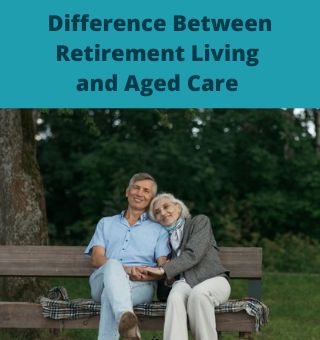Growing older is an inevitable part of life, and there may come the point when your living arrangements will have to change to accommodate your changing lifestyle or healthcare needs.
Retirement living and aged care provide supportive environments for older Australians, but there are many misconceptions surrounding both options.
All too often, people get confused about the two when they start planning the next stage of their lives. Knowing the unique qualities and benefits of retirement living vs aged care will help you decide which is best for you or your loved one.
Hopefully, by the time you finish reading this article, you’ll have an easier time making an informed choice.
So, What Exactly Is the Difference Between Retirement Living and Aged Care?
In a nutshell, retirement living is driven by lifestyle choices, whereas aged care is driven by care needs.
Retirement villages are designed for folks over 55 who are still active enough to live independently and don’t require significant medical attention. Villages are a good option if you want to enjoy the benefits of living in a close community of like-minded people.
An aged care home provides increased support for seniors who can no longer live independently, with round-the-clock personal or nursing care available.
To better understand the difference, let’s delve deeper into the two options for supported living.
Legislation and Regulation
Retirement Living
Retirement villages are governed by state government rules and regulations and are fully paid for by the resident through personal finances, pension, or superannuation.
In retirement living, you enter into a private contract/agreement with the village. The Retirement Villages Act 1999 (Qld) promotes consumer protection and fair-trading practices in retirement villages.
Aged Care
Aged care is governed by commonwealth government legislation and regulation.
The Australian government subsidises aged care for eligible people and guarantees a high quality of care and accommodation for the recipients of aged care.
Aged care agreements fall under the Aged Care Act 1997 (Cth). Before entering a residential aged care home, you’ll have to undergo an ACAT (Aged Care) assessment to determine whether you qualify.
The assessment considers factors like your health, physical needs, social needs, medical history, psychological requirements, and any other special needs.
Accommodation
Retirement Living
Retirement villages generally consist of multi-unit complexes with common areas. They offer residents a living arrangement alternative to staying in their private homes.
As a resident, you can live independently and privately in a detached home, townhouse, villa unit or self-contained apartment.
A management office is usually on-site and management tends to be more hands-on than on standard strata buildings.
Aged Care
Rather than self-contained apartments, aged care facilities provide private rooms with en-suites or shared rooms.
These facilities feature common areas for lifestyle and socialising activities while still offering residents personal space to call their own.
Nature of Ownership
Retirement Living
When you move into a retirement village, you’ll receive a licence which is essentially only a right to live in the property, meaning you’ll not have ownership of the property.
Aged Care
If you opt for the aged care route, you can either “rent” the room and pay a daily fee for care or “buy”, which is cheaper.
Medical Care
Retirement Living
You’ll be responsible for your health and well-being in a retirement village. However, some retirement villages feature emergency buttons in case you fall or require assistance.
In the event of an emergency, there will typically be someone at the security office or front desk who can be contacted.
Aged Care
People are put in aged care facilities because they need more care and support.
Since these facilities are set up with health care in mind, they have on-site trained nursing staff 24/7. It’s common to find a doctor’s office on site.
As a resident, you’ll be monitored regularly and if you’re sick, daily health checks are provided and medication is administered.
Services and Facilities
Retirement Living
Services and facilities offered depend on the village.
They may include gyms, spas, swimming pools, underground parking, libraries, community gardens, croquet lawns, restaurants, beauty salons, bars, and lounges.
Aged Care
Aged care facilities are mostly self-contained, with a kitchen, dining room and chef on-site.
In most cases, there will be TVs in every resident’s room, but there are also shared entertainment areas.
Other services and facilities include facility gardens, common sitting areas, men’s shades, cafés, consulting rooms, tennis courts, and bowling greens.
Access
Retirement Living
When you move into a retirement village, your home is yours.
You’re free to decorate the place the way you please, invite family and friends to stay, and generally treat the space as you would any home.
Pet ownership is at the discretion of the village management.
Aged Care
Aged care facilities are normally more structured and most have fixed visiting hours.
Guests (and residents) need to check in on arrival and check out when they leave the facility.
Regarding pet ownership, some aged care facilities allow support animals. Who is allowed to be a pet parent is usually done on a case-by-case basis.
Applicable Fees
Retirement Living
Before relocating to a retirement village, you may be required to pay a down payment to hold your place in the village.
Upon entry, you will pay an ingoing contribution, aka the purchase price.
Ongoing fees for residents in retirement villages include Maintenance Reserve Fund Contribution (“MRFC”) and a General Services Charge (“GSC”).
Besides the ongoing fees, you’ll also be responsible for personal expenses such as cleaning, laundry and meals.
After you leave the village, you’ll be required to pay an exit fee, outstanding GSC or personal service charges, as well as any other contractual payments owed.
Aged Care
Aged care homes are by no means cheap – residents in aged care facilities must pay fees to cover care and accommodation.
The accommodation fees can be paid by a Daily Accommodation Payment (“DAP”), a Refundable Accommodation Deposit (“RAD”), or a combination of both.
Daily care fee is used for day-to-day living costs like cleaning, laundry, and meals.
The day you depart from the facility, the RAD will be refunded to you (or your estate) within 14 days.
It is important to read the fine print so you know what you’ll be up for financially while living in an aged care facility.
Conclusion
As we get older, choices about where we want to live start to be affected by lifestyle or health.
If you’re looking to downsize from the place you’ve called home for most of your life, then it makes sense to know what options are available to you.
Retirement living is meant for over 55s who are fully capable of living independently, while aged care helps support older adults with high care needs.
If you have any questions, consulting with a Retirement Village Expert is a great way to learn more about your best options. Get in touch now with one of our Retirement Village Experts.


